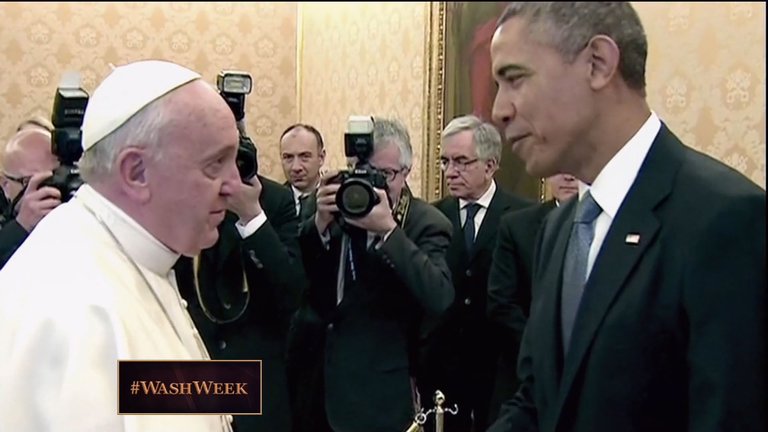
Video Currently Unavailable
Web Video: President Obama Meets Pope Francis
May. 24, 2017 AT 4:22 p.m. EDT
TRANSCRIPT
Notice: Transcripts are machine and human generated and lightly edited for accuracy. They may contain errors.
MS. IFILL: The standoff with Russia may have been front of mind for the U.S. president, but another interesting tableau unfolded abroad this week as well. The liberal Democratic U.S. president met with the conservative Catholic Argentinian pope. Everything seemed cordial enough. But afterward, one side chose to emphasize what the two had in common while the other focused on areas of difference. Each had its own domestic reasons for that approach, didn’t they, Doyle?
MR. MCMANUS: They did, Gwen. I – we don’t often talk about the pope as a political leader with a domestic constituency, but you can kind of make that analogy.
Let’s start with President Obama, though, because he’s easier. He needed one thing out of this meeting. He needed a nice picture of himself smiling next to the pope, the most popular person in the world right now – not Barack Obama, the pope – with the pope’s –
(Cross talk)
But he got that. He got all the pictures. They were lovely. And then the president afterwards gave his readout of the meeting. And it was sweetness and light. It was about the common ground on poverty and the common ground on world peace and the fact they were going to work together.
And then a little after that the Vatican, as it tends to do, put out a very spare statement that – it had points of common interest in it, it had all the international stuff as well that they had talked about, the Middle East and so on, but it also had this line saying, the two sides also discussed their differences on religious freedom, life and conscientious objection. And what that is, is Vatican-speak for abortion and the exemptions that Catholic institutions in this country want from the Affordable Care Act requirement that they cover contraception. Incidentally, that weird phrasing was also because the Vatican did a kind of a good cop, bad cop act. The secretary of state, Pietro Parolin, was the one who did the tough stuff on abortion.
MS. IFILL: Right. But also – but also, when you talk about the pope’s domestic constituency, it’s American bishops in this case, right?
MR. MCMANUS: That’s right. I mean, it’s wrong to think of the pope as a politician in the sense of having a political agenda, but he does have a specific political and bureaucratic agenda, which is quite far-reaching reform of the Vatican. And part of that is empowering bishops conferences in each country. So even though we don’t know how much he agrees with the approach the American bishops have taken, he does want to defer to them and back them up, and that’s exactly – (inaudible).
MS. BISKUPIC: Well, on that question, though, in terms of what President Obama could do possibly with the pope, he made those comments that we just saw about, really, there’s no practical partnership that might come out of this, but what about any kind of opportunities for diplomacy, I would think, given the personalities we’ve got here?
MR. MCMANUS: That actually is there. And if you think of it, of course, the high water mark in a sense in modern times was President Reagan and Pope John Paul II, the Polish pope, and they did a whole lot of stuff in Eastern Europe. There’s probably not as much opportunity here, and in fact, the two – the Vatican and the White House disagree on some issues in Syria, for example. But in the Middle East, the Vatican is quite engaged. They can do – they can do some work there. It is – the Vatican is trying to get the Syrian regime of Bashar Assad to be more forthcoming in negotiations. They’re not having any more luck, though, than the Russians are.

© 1996 - 2025 WETA. All Rights Reserved.
PBS is a 501(c)(3) not-for-profit organization
